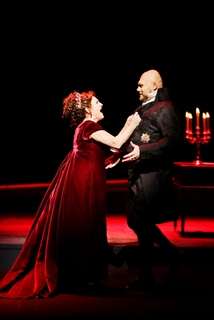|
Back
Let your heart weep for Tosca! Copenhagen
The Royal Danish Opera House, Main Stage
09/10/2011 - & September 14, 16, 18*, 21, 23, 25, 27, 29, October 1, 3, 5, 8, 22, 24, 26, 28, November 4, 11, 2011
Giacomo Puccini: Tosca
Gitta-Maria Sjöberg*/Anne Margrethe Dahl (Tosca), Stuart Neill*/Andrew Richards/Jean-Pierre Furlan (Mario Cavaradossi), John Lundgren*/Christopher Robertson (Scarpia), Sten Byriel*/Hans Lawaetz (Angelotti), Anders Jakobsson (A sacristan), Torleif Steinstø*/Bengt-Ola Morgny (Spoletta), Rudi Sisseck*/Ole Jegindø Norup (Sciarrone), Torben Demstrup*/Henning von Schulman (A jailer), Emil la Cour Bødtcher-Jensen*/Oscar Flensborg Svane (A shepherd boy)
The Danish Boys’ Chorus, Anne Marie Granau and Kristine Vad (chorus masters), The Copenhagen Boys’ Choir, Tina Jarl and Ulrik Solberg (chorus masters), The Royal Danish Opera Orchestra and Chorus, Philip White (chorus master), Giuliano Carella (conductor)
Peter Langdal (director) assisted by Anne Fugl, Karin Betz (set and costume designer), Jesper Kongshaug (lighting designer), Signe Krogh (video graphics)

G.-M. Sjöberg & J. Lundgren
(© Miklos Szabo/Courtesy of Royal Danish Opera)
The Royal Danish Opera has opened the 2011-12 season with director Peter Langdal’s revival production of Giacomo Puccini’s Tosca, a production well worth seeing for the first time or yet again, with new faces among the roles and Italian opera expert Giuliano Carella (conductor) leading the Royal Danish Opera Orchestra with its roster of fine musicians.
Along with the orchestra, the principals stole the show. Gitta-Marie Sjöberg (Tosca) sang masterfully with the full range of emotions that are required. Jealous from the start and flirtatious with her man, Sjöberg’s Tosca is a natural woman whose naiveté is quite straightforward, and who cannot imagine the evil depths of the man who is about to destroy her. Sjöberg embodied Tosca with gestures, expressions, body language and a wonderful strong dramatic soprano that combined well with the large tenor of Stuart Neill (Cavaradossi). The lyrical quality of Sjöberg’s voice remained present throughout; she was both innocence and passion, which heightened Tosca's tragedy.
Stuart Neill’s large voice carried easily above the orchestra in all its nuances. His commensurately large figure did not hinder his movement appreciably, and he even created a comic moment with an impossible embrace of the sacristan in Act I. With the orchestra’s lovely cellos first mournfully reiterating the love theme, and the clarinet solo crying wistfully and alone, Neill’s "E lucevan le stelle" was memorable, and his "Recondita armonia" in Act I harvested extra applause.
John Lundgren (Scarpia) – playing the masculine sadist, dark beard framing a pale face and perfectly costumed for the role - stormed down the cathedral flanked by his two lieutenants. His bold manner reinforced his rich baritone. For a moment, he captivated the jealous Tosca, who turned away in shock having looked into his hard soul. With self-confidence and charisma, Lundgren carried the part magnificently.
Sten Byriel (Angelotti), in long locks of disarray, portrayed the escaped statesman quite credibly; Anders Jakobsson (Sacristan) cut a jolly figure with the boys’ and men’s choirs in shades of red; Torleif Steinstø (Spoletta) was a smirking conniver, truly the extended arm of Scarpia; Emil la Cour Bødtcher-Jensen (A shepherd boy) delivered his clear song center stage (instead of backstage) with great composure. The Royal Danish Opera Chorus in the "Te Deum" must also be complimented for their overwhelming sound, just what is needed at the close of Act I. They are fine singers who deliver supporting roles with competent singers like Steinstø, Rudi Sisseck (Sciarrone), and Torben Demstrup (A jailer).
Langdal and his production team delivered a changing physical and virtual setting that was perfectly coordinated with the tempo determined by Carella, and in which the players moved about quite naturally (not an easy task). Karin Betz (set and costume designer) placed the characters in costumes from the early 1800’s and created the basis for three historical backdrops using a sparse modern framework. The floor and walls pivoted and changed, and events happened upstage as well as center stage. Musicians played upstage in Act II and were abruptly blacked out by a single motion from Lundgren; Neill (Cavaradossi) moaned in a distant prison cell, and shepherd boys rose from sleep in the early morning.
Jesper Kongshaug (lighting designer) and Signe Krogh (video graphics) used color to heighten our emotional perception of the unfolding events, starting with blood-red floors of the cathedral as Angelotti seeks shelter. Projections and lighting rendered the details of the cathedral, Scarpia’s headquarters, and the prison tower, and the team aimed throughout to underscore Puccini’s high intensity drama.
Making it all hang together, of course, was the Royal Danish Opera Orchestra, an experience in its own right, to which the Danish public flocks to hear in concert several times each season. An assembly of soloists, the orchestra is perfect for music by Puccini, who singles out orchestra voices to express emotions of individuals. And Giuliano Carella fully delivered the variation and intensity that we desire in the music of Tosca.
I shed tears as Tosca leaped to her death after commending Scarpia to the wrath of God, with the orchestra repeating Cavaradossi’s "E muoio disperato! E non ho amato mai tanto la vita". It was a bitter ending that drove in the injustice that can be caused by individuals and systems of unrestricted power.
Kathleen Gail Jensen
|